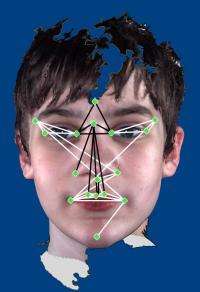Autistic facial characteristics identified

The face and brain develop in coordination, with each influencing the other, beginning in the embryo and continuing through adolescence. Now, University of Missouri researchers have found distinct differences between the facial characteristics of children with autism compared to those of typically developing children. This knowledge could help researchers understand the origins of autism.
"There is no clear answer about whether autism is caused by genetics or by environmental influences," said Kristina Aldridge, lead author and assistant professor of anatomy in the MU School of Medicine and the Thompson Center for Autism and Neurodevelopmental Disorders. "If we can identify when these facial changes occur, we could pinpoint when autism may begin to develop in a child. Knowing that point in time could lead us to identify a genetic cause, a window of time when the embryo may be susceptible to an environmental factor, or both."
Aldridge and colleagues found the following distinct differences between facial characteristics of children with autism and those of typically developing children:
- Children with autism have a broader upper face, including wider eyes.
- Children with autism have a shorter middle region of the face, including the cheeks and nose.
- Children with autism have a broader or wider mouth and philtrum – the divot below the nose, above the top lip.

Aldridge analyzed 64 boys with autism and 41 typically developing boys aged eight to 12 years old, using a camera system that captures a 3-D image of each child's head. Then, she mapped 17 points on the face, such as the corner of the eye and the divot in the upper lip. When Aldridge calculated the overall geometry of the face using these points, and compared children with autism and typically developing children, she found statistically significant differences in face shape.
Understanding that people with autism have statistically different facial characteristics enables researchers to focus on the underlying causes of autism, Aldridge said. Additionally, the study identified two groups of children with autism who show further distinct facial traits that occur in children with specific characteristics of autism, such as behavior problems, language level and repetitive behaviors. Identifying these subgroups within the group of children with autism allows better study of these children and why autism is so variable.
"This research would not be possible without the children and their families that participated," Aldridge said. "Their help is key to advancing research and helping us better understand autism, and how to develop better treatments. We are also indebted to the University of Missouri's Thompson Center for Autism and Neurodevelopmental Disorders for their support of this project and the care it provides for children with autism and their families in Missouri."
The study was published in Molecular Autism. Aldridge collaborated with Ian George, a graduate student in the School of Medicine; Kimberly Cole, a research technician at the School of Medicine; Jordan Austin, a senior in the College of Arts and Science; T. Nicole Takahashi, project director at the Thompson Center for Autism and Neurodevelopmental Disorders; Ye Duan, associate professor of computer science in the College of Engineering and the Thompson Center; Judith Miles, professor emerita in the School of Medicine and the Thompson Center. The entire team is affiliated with the Thompson Center. This research was supported by an Autism Spectrum Disorder Research Program grant, the Simons Foundation and the Thompson Center Research Scholar Funds.
















